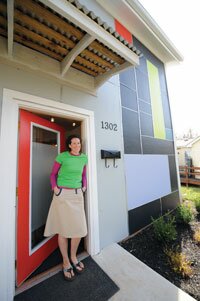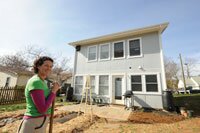Girl gone green: Ballerina turns builder in Fifeville

Hope Sowell and her house.
Photo by Jen Fariello

Projecting eaves, a bat house, and rain barrels are among the eco-friendly attributes of Sowell's self-built house.
Photo by Jen Fariello

There's nothing quite like it on King Street.
Photo by Jen Fariello
As Hope Sowell takes a visitor through her modern, light-filled house in Charlottesville's Fifeville neighborhood, she takes special pride in showing the spacious ground floor space, divided into living room, kitchen, and office. Three picture windows look onto the long green lawn. A bar with stools separates the bright lime kitchen from the living area. By the back door, a deep purple bathroom sports a wall of many mirrors, and out the back door the builder laid a simple patio.
Sowell, however, is no ordinary 20-something hostess boasting about decor; she is a builder who constructed this energy efficient house, and she did it essentially on her own.
Tall and athletic, Sowell says she's always been handy. She was drawn to construction work the summer after she finished high school when she got a job with a framing crew.
"At first, I just dug ditches and used the jackhammer," says Sowell, "but then I started building."
Ten years later, Sowell's charming contemporary house– with its small, square footprint, its tall height, and boldly colored panels– stands out like a Mondrian painting in the midst of simple, twentieth century cottages on King Street in Charlottesville's Fifeville neighborhood.
Sowell herself must have stood out herself working on construction crews in Pittsylvania County near Danville. No one in her family was in the building trades, except for a grandfather, a plumber who lived far away.
Still, the seeds of her construction career were sown early, although she was never one to shun girly activities, enjoying Legos and dolls equally as a child. Instead of sports, she notes, "I went the ballet route."
In 1998, Sowell came to the University of Virginia as an architecture student, but soon switched to urban planning. She had already decided to become a builder and wanted a broader scope of study. For practical experience, she continued to work summer jobs in construction and did one stint on the maintenance crew for the Architecture School.
Despite her drive and growing experience, finding a job was not always easy in the male-dominated construction industry. "A lot of places I'd call to see if they needed any help," she recalls. "They would say, ‘No ma'am, I don't think so.'"
Despite rejections, Sowell says she pushed on.
"I used to try to prove myself." Sowell explained. At Lowe's they would say, "Do you need help loading these boards?" and I would say "No."
Confidence changed that.
Now I say, "Yes, you can do it!" she laughs. "I don't think building a good reputation is about proving yourself physically. It's more about doing good work."
After college, she joined the Clinton-launched public service program Americorps and landed a job in Charlottesville for Habitat for Humanity.
"She worked her fanny off," recalls Diane Hogshire, Habitat's then assistant director who hired Sowell. Indeed, Sowell says, she felt burned out after long hours at Habitat including some 60-hour weeks– but she wasn't put off construction.
Albemarle Housing Improvement Project (AHIP) hired Sowell as a crew leader, but it wasn't long before she set out on her own with a contract to do a construction job in the high-end Farmington neighborhood.
"I had my truck," she says, "and I had my tools." Sowell Construction and Design was launched.
After completing the Farmington job, she built a home addition "from the ground up," remodeled a two-car garage into a family room, and renovated a series of bathrooms.
"I like to do bathrooms because I can use my design skills and don't get bored," she notes
Former Habitat exec Hogshire has hired Sowell to do several home renovations, the last a complete redesign of her own master bathroom. She describes Sowell as "a rare talent, innovative and flexible."
"She can hear your ideas," Hogshire notes, "because she doesn't have a giant ego."
After doing multiple jobs for others, Sowell bought a fixer-upper for herself on West Street. Enjoying the process of restoring her own living space, it wasn't long before Hope saw the lot on King Street and envisioned building her own house on the land. "I could afford it," she says she realized. "I got a loan for construction and to pay myself."
She also hired an assistant, Ross McDermott, a photographer with little construction experience.
"He had a good attitude," says Sowell.
Ross is equally flattering of his building mentor, praising her ability to design, build and serve as interior decorator.
As for her gender, McDermott claims anyone who doubts she's tough or strong enough need only spend a few hours working alongside her.
"I'd hire her in a heartbeat," he says. "She outworked me sometimes."
As for the finished product– her own house– it's small, 1,150 square feet, but it seems much larger because of the Sowell's use of space and light. The house stands on a 60- by 150-foot lot which cost $90,000. Everything else, materials, subcontractors and her own salary came to $136,000.
The green features begin outside, where a narrow, permeable gravel walk leads to her bright red front door. A natural wood staircase leads up to a huge white room with many windows. In one corner, Sowell made a small loft for a guest bed and under it a bathroom with a big soaking tub for a tired carpenter.
Green features of her masterpiece are significant: ultra-insulation, passive solar heat, energy-efficient appliances and non-toxic finishes and paint. Sowell has plans to add an extra room on the back and to cover the patio.
Sowell subcontracted out the concrete foundation and footers, the spray-in foam insulation, and the drywall. For those jobs she wanted people with the proper tools and expertise.
"I knew people I trusted," she says, noting, "It actually boosted my self-esteem to manage the subcontractors."
The construction took five months to complete, from early December of 2007 to the 1st of May of 2008. During that time Sowell worked only at her site, paying herself from her loan as if she were a client.
Her neighbors have been accepting, if not entirely positive.
"Most are an older generation, and I imagine they are not into modern design," Sowell muses. "But I doubt if we should perpetuate some of those older designs. At some point, you need to break the mold and do something new."
#
1 comment
Any chance you'll have an open house, this looks terrific. Congratulations Hope, this is inspirational. As a woman I've started several businesses and the one thing I'd say is don't wait until you know enough to begin, just start and learn by doing and don't worry about being perfect no one is, the best way to learn something is by doing it